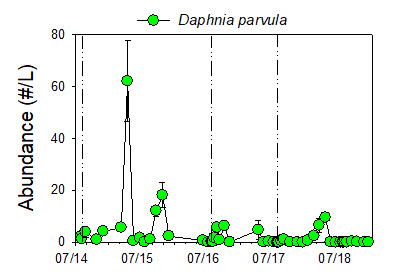Just for fun and as food for thought, check out these two reports of contrasting lake conditions–one a blog post and the other a news story–that provide an interesting contrast in lake ecology and how conditions may vary from year to year.
 The blog post is a nice, readable explanation of what lake scientists call the “spring clear water phase.”
The blog post is a nice, readable explanation of what lake scientists call the “spring clear water phase.”
https://blog.limnology.wisc.edu/2020/05/13/cool-weather-means-clear-waters-for-wisconsin-lakes/
A spring clear water phase as described is common in northern lakes, not so common further south.
In brief, large bodied zooplankton (Daphnia) are abundant and eat much of the phytoplankton, leading to clear water. Fish then eat the Daphnia and the clear water phase ends.
Every now and then we can see a brief clear water phase at Lake Wister in the results of the zooplankton sampling we do.
This is most evident in 2015, but you can see small large-bodied Daphia peaks around the same time in most years (thank you Andy Dzialowski for the zooplankton analysis).
The news report is about an early season algae bloom at Beaver Lake in NW Arkansas.
Beaver Lake traditionally has a taste and odor event around August every year, not this time of year.
Why Beaver sometimes has an algae bloom this time of year is not completely understood, but it likely is driven by nutrients flushed into shallow parts of the lake where the algae multiples, and then are moved from the shallow areas to other areas of the lake downstream, including to the Beaver Water District source water intake. (Read Reed & Hufhines 2017 explanation of uroglena in Lake & Reservoir Management: https://www.tandfonline.com/doi/abs/10.1080/10402381.2016.1238427/ ).
A few years ago, we documented an unusual algae bloom in Lake Wister in February that caused a significant taste and odor event. It was caused by a cold water diatom, not our usual cyanobacterial suspects, that was happily growing about 6′ down, and not visible on the lake surface.
